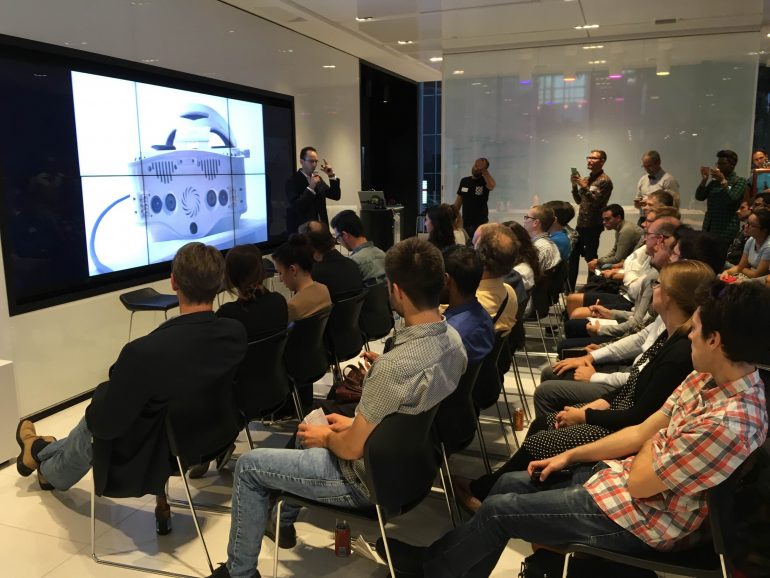Pour lire cet article en français, cliquez ici.
Since 2014, We Are Wearables has grown from an event including founder Tom Emrich showing off a box of wearables to a room of wearable tech enthusiasts, to a strong community of 100,000 members convening in cities like Toronto, Chicago, and Ottawa. As the community continues to grow, the wearable tech hype has spilled over to Montreal, which hosted its first edition of We Are Wearables Montreal last week at the Desjardins Lab.
Mighty Cast opened the evening with CEO Adam Adelman presenting the new version of its smart bracelet, NEX. NEX provides certain features of smartwatches and bracelets that are already on the market—such as receiving notifications related to social networks or adjusting the sound of a stereo without having to move—but it’s unique in that it offers customized settings. For instance, a user could decide to tap NEX twice to turn on the espresso machine in the morning, or two taps to open a garage door. “The biggest differentiation [between watches and smart bracelets] is price,” explained Adelman, insisting that Mighty Cast offers affordability with the goal of democratizing wearable technologies.
“Unfortunately, people outside of Canada don’t understand the benefits of having an office here and doing R&D.”
Jean-Philip Poulin, Sensaura COO, then took the floor to explain their technology platform, which wants to use decoded emotions from physiological signals and algorithms to justify decision-making. Sensaura shared their monitoring system that can be worn on one’s body and sends signals to an “insights engine” which subsequently produces predictive analytics. In short, an attentive wearable technology that analyzes, recommends, and predicts behaviour.
Sensaura is, however, still in the preliminary stages, and is well aware that the vast range of emotions, with all the nuances that make it up, cannot be determined solely through physiological signals. Physical signs should also be taken into account. In addition, although knowledge of our inner state could give others a better form of understanding, how likely is it that we would really want to let others in?
The future of wearables. Don't think without the body said @berzowska @Concordia #WWMTL #Desjardinslab @mtlnewtech pic.twitter.com/TZ31ybK0HW
— Sylvie Gendreau (@SylvieGendreau) September 15, 2016
Marc-Olivier Lepage, COO and co-founder of Vrvana, subsequently unveiled the new version of their virtual reality glasses: Totem. With their 120-degree field of vision, Totem surpasses Hololens, and also offers “hardware accelerating colour keying”: a green screen that offers a wider variety of immersive experiences, ranging from visualization to collaborative design to e-learning.
Interesting new startups like @MightyCast still emerge in #Wearables #desjardinslab #WWMTL @hackinghealthca pic.twitter.com/QA77EXpBxP
— HH Accelerator (@hhaccelerator) September 14, 2016
The evening culminated with a panel discussion with Adelman, Lepage, BioMindR project lead and WWMTL co-founder Meryeme Lahmami, Motion Engine CEO Louis Ross, and Joana Berzowska, head of electronic textiles for OMSignal. They discussed the challenges and opportunities of wearable technology by emphasizing the importance of software. “We are focusing almost entirely on our software and we think that is what brings the dynamic experience that is currently lacking in a lot of wearables,” said Adelman. The panelists also talked about the strength of Montreal’s ecosystem, including its great tech talent pool and low cost of living that make the city favourite spot for tech startups. “There are many both educational and research institutions, and we have really good programs for funding,” said Berzowska. Recently, the City of Montreal announced a $100 million fund for smart city startups.
At the end of the presentations, attendees had the opportunity to chat with the Mighty Cast, Vrvana, and OMSignal teams to learn more about their products and even try them out. “Unfortunately, people outside of Canada don’t understand the benefits of having an office here and doing R&D, and the amount of money that’s spent to educate Masters and PhD students. There’s great talent here in the areas we’re interested in, which include textiles, machine learning, and AI,” said Ross.


